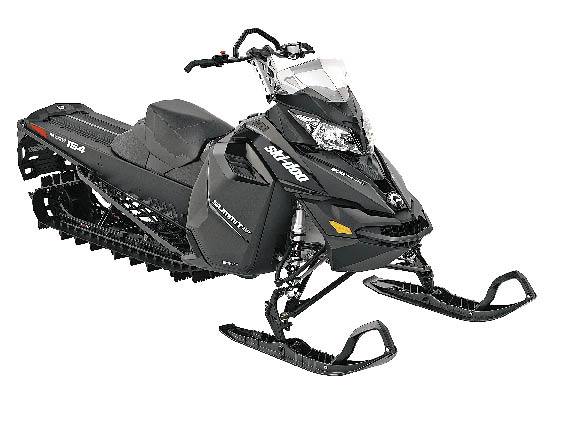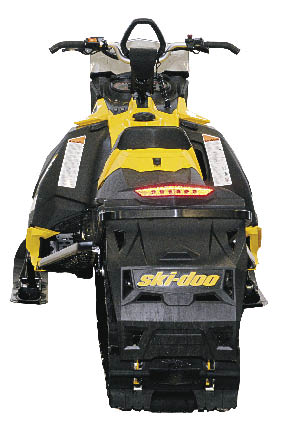 Not many will argue that Ski-Doo is on a roll in the mountains, thanks to its new Rev XM platform unveiled in the Summit lineup last season. That along with the tMotion rear suspension has literally—and figuratively—helped propel Ski-Doo to greater heights in the mountains.
Not many will argue that Ski-Doo is on a roll in the mountains, thanks to its new Rev XM platform unveiled in the Summit lineup last season. That along with the tMotion rear suspension has literally—and figuratively—helped propel Ski-Doo to greater heights in the mountains.
The new chassis and suspension helped the Summit X 800R become the best-selling sled in model year 2013 (through the middle of January, 2013) and seriously challenge the Polaris 800 Pro RMK as King of the Hill.
“2013 was one of our greatest years—significantly,” Philippe Normand, Ski-Doo marketing director, said. No doubt Ski-Doo is on a roll as we get ready to close out this winter and look to model year 2014, which marks the 20th anniversary of the first Summit snowmobile.
With the success of its XM platform in the 800cc class, isn’t it logical that Ski-Doo would next set its sights on the 600cc class and also the freeride class? Consider it done.
Ski-Doo has expanded its Rev XM chassis offering to its 2014 Freeride sleds (137, 146, 154-inch track) and the Summit SP 600 E-Tec. That means for 2014, the only Summits not in the XM chassis are the Sport 600 carb and Sport PowerT.E.K. 800R. Along with the expansion of the XM platform to the additional models, Ski-Doo is including as standard fare the revised Pilot DS 2 skis and ski spindle.
Use Of Pilot DS 2 Skis Expanded
The Pilot DS 2 skis feature a single keel for better sidehilling and are relatively narrow and thin. Another key to the success of the skis is that the distance behind the spindle to the back of the ski has been shortened while the rear of the ski has a flat tail for easier counter-steering and sidehilling.
The XM platform has a number of features that have helped transform the Summits (and now Freerides) into backcountry dominators. Those features include the narrow seat, minimalist-designed handlebar controls, narrow ski stance, tapered aluminum handlebar with rigid grab strap, much improved running boards with large holes so snow won’t build up and 1-gallon glove box. All those features are now spread across more of the Summit line so that more riders can enjoy the features that only a few could on select model year 2013 sleds.
You can add to the expansion of the XM chassis the inclusion of the tMotion rear suspension (which allows the suspension to flex laterally in the tunnel) on more models, including all Summits (even the Sport 600 carb and Sport PowerT.E.K. 800R) for 2014. The Freeride 146 and 154 also get the tMotion while the 137 gets the rMotion. The third part of the package that has really improved the maneuverability of the Summit--the FlexEdge track--will also be included in all Summits and Freerides except the Freeride 137. You might remember that the FlexEdge track allows the outer two inches of the track to bend, improving sidehilling and being able to roll the machine up on its side.
We’re especially excited about the Summit SP 600. Now the mountain 600cc class is that much more competitive.
 Running Through The Lineup
Running Through The Lineup
Let’s look at each version of the Summit and Freeride for 2014.
The Summit X, targeted at those riders who favor the steep and deep, returns much the same for 2014 with three track options--146-, 154- and 163-inch--and one engine, the powerful and ultra-smooth liquid-cooled Rotax 800 E-Tec. The track is the PowderMax II, which is 16 inches wide and has 2.5-inch deep lugs.
At 36 inches, the ski stance is narrow, narrow, narrow. That’s two inches narrower than the Arctic Cat M 800 Sno Pro and three inches narrower than the Polaris 800 Pro RMK. You can adjust the ski stance from 35.7 to 37.4 inches.
The gauges have been updated to include a couple of cool new features. Those are a “Rev limiter” warning that displays when the rpm reaches 8,300 to alert the driver to change the clutch setting and a start-up screen that indicates the percentage of engine break-in remaining. Once the break-in period is past, the message disappears. The message is displayed when the sled is started.
Another feature of the new gauge is the parking brake pilot light. How that works is if you try to drive the sled with the parking brake still engaged, the sled will “beep” and a light will flash on the gauge to alert you of the problem.
The standard gauge on Rev XM models include a new indicator for hand and thumb warmer intensity and the parking brake pilot light.
Of course, the X also offers a higher end shock package, which includes HPG Plus shocks on the front and rear suspensions.

 Summit XP
Summit XP
Moving on to the Summit SP models, again, the big news is the move to the XM platform for the 600 E-Tec, one of two engine options for the SP. The other engine option is the 800R E-Tec, which in model year 2013 was already in the XM chassis. Track options vary for each model. Three track lengths are available in SP skin: 146, 154 or 163 inches, all 16 inches wide, for the 800. The PowderMax II track with FlexEdge on the 800 SP has 2.5-inch deep lugs. On the 600 the lugs are 2.25 inches deep and come in 146 or 154 inches. The SP models have good shocks—HPG—just not the HPG Plus like on the X. The SP still has a great ride, though.
Next in the Summit lineup are the Sport models, which are seen as price-point sleds. The engines are more basic—600cc carbureted or 800cc PowerT.E.K. (with a claimed 151 hp) powerplants—and the shock packages are more basic as well with a mix of Motion Control and HPG shocks. That’s part of the reason these vehicles are as much as $2,000 less than SP models. The Sport models do get some upgrades for 2014, including, as mentioned, the tMotion rear suspension and Pilot DS 2 skis. Track lengths for these two Sport models are 16x146x2.25 inches (600 carb) or 16x154x2.25 inches (800 PowerT.E.K.). The Sport models are still housed in the Rev XP chassis, the same platform all other Summits were in before going to the XM chassis.
In the Freeride lineup are sleds specifically designed and built for aggressive off-trail riders, mostly mountain riders who frequent the western U.S. and Canada. Aggressive flatland riders might argue, though, that the Freeride 137 is ideal for them to pound through the woods in the Midwest and eastern portions of the U.S. and Canada. Regardless, all Freerides get the Rev XM RS platform which will make riding off-trail that much easier and more fun.
The RS part of the XM platform means the Freeride is using the same strong and lightweight chassis that is used on the MX Zx 600RS race sled, which includes most reinforcements (riders of the Freeride tend to like to jump and reinforcements are handy for this type of riding) and wide, strong running boards with an extruded edge. This platform uses the XM running board pattern of holes to help the snow drop out more easily.
In addition to the 137-inch Freeride, other tracks are the 146- and 154-inch. We’ve already mentioned the tMotion and rMotion rear suspensions and FlexEdge track but we shouldn’t discount how those features will affect (read: improve) the Freerides. It will allow aggressive riders to be just that much more aggressive in the backcountry with the added confidence of knowing exactly how the sled will react in certain conditions, especially when sidehilling and boondocking through the trees.
The Freerides also use KYB Pro 40 piggyback shocks for easy adjustment and better durability under aggressive riding conditions. Ski-Doo is also using the Pilot DS 2 skis on the Freerides.
The Freerides’ powerplant is the Rotax E-Tec 800R.
Another Freeride exclusive is the multi-function digital gauge with display and a five-minute of high sampling rate record mode.
One change Ski-Doo made on all E-Tec equipped models (not just Summits and Freerides) is new 32W (vs. previous 28W) hand warmers which crank out 15 percent more heating power and have 50 percent more warming power while the sled is idling.